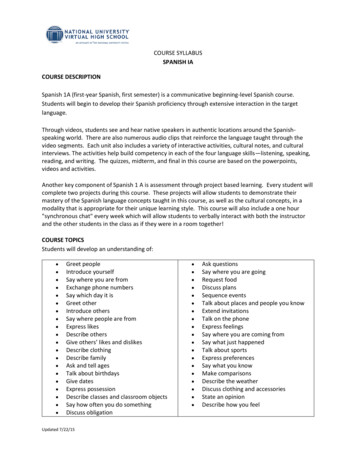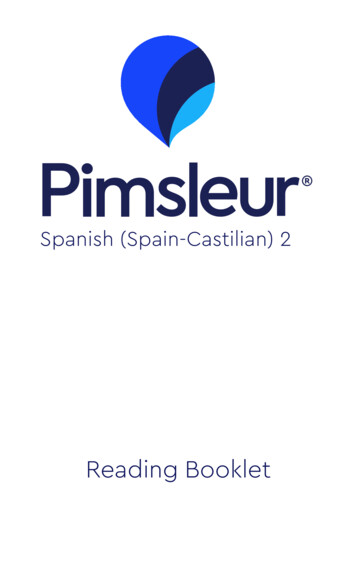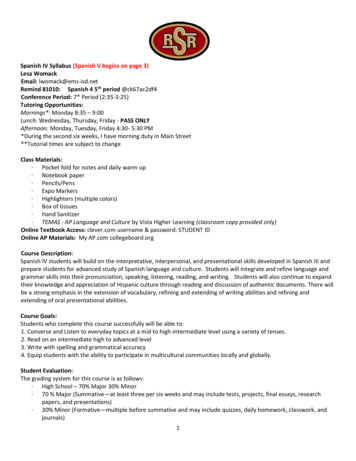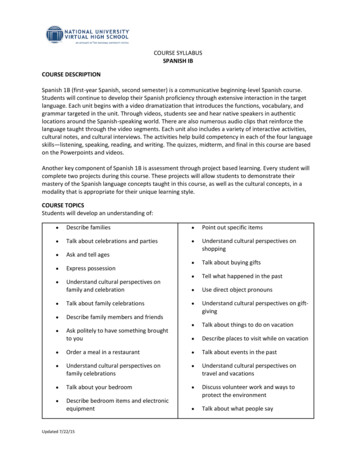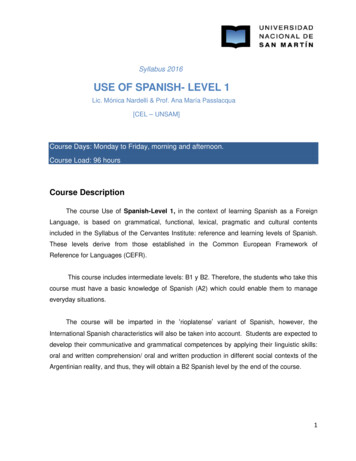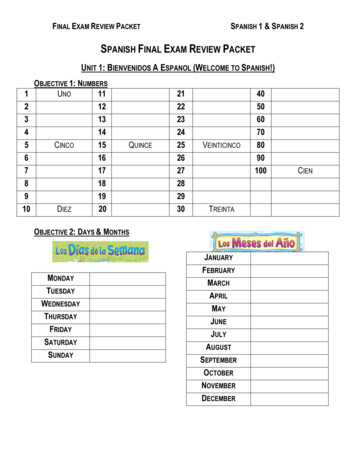
Transcription
COURSE SYLLABUSspanish level 1Teacher:Mrs. Martina BexEmail:Telephone:martinaebex@gmail.com777 777 7777Extra help:I teach at BCS part-time, so you will need to make special arrangementsfor extra help with me. The best time to get extra help is during lunch,but we can make other arrangements if that does not work for you.Materials: A 1.5” 3-ring binder with dividers Loose leaf paper A pen or pencilA Spanish/English dictionaryis not required, but it wouldbe good to have one at home.COURSE DESCRIPTIONIn this course, our goal will be to acquire Spanish language. “Acquiring” a language is verydifferent than “learning” a language. Acquiring is something that happens to you instead ofsomething that you make happen. When you learned how to speak your first language, youacquired it naturally by listening to other people speak it around you for a long time; not bystudying it. Therefore, almost all of our class time will be spent using Spanish--not using Englishto talk about Spanish--and the focus will be on listening and reading instead of speaking andwriting. Those skills will come naturally as you take in more and more Spanish by listening andreading, but they will not be a major focus of the course. This Spanish course is aComprehensible Input Spanish course, and we will use methods andstrategies that are based on Dr. Stephen Krashen’s Input Hypothesis.In particular, we will use the TPRS (Teaching Proficiency throughReading and Storytelling) method of language instruction that wasdeveloped by Blaine Ray and based on the work of Dr. James Asher.We will focus our class time on the acquisition of high frequencystructures (the most frequently used words in a language); betweenthree and six new target structures each week. (You will learn morethan this, but you will only assessed on the target structures.) We will use these structuresin class discussions, stories, and cultural explorations, and you will be expected to recognize themwhen you read or hear them and, in time, be able to produce them in speech and writing.Before the year ends, you will read the novel Agentes secretos y el mural de Picasso, by MiraCanion, and possibly the novel Esperanza, by Carol Gaab.Developed by Martina Bex www.martinabex.com The Comprehensible Classroom
EXPECTATIONS – Your Keys to Success!Because I have high expectations for you, I also have high expectations formyself. I expect you to be respectful, responsible students, and I will inturn be a respectful, responsible teacher.Student Responsibilities Speak Spanish, not English!Be respectful of yourself, your teachers, yourclassmates, and your school.Come to class prepared with the materials youneed to do your work.Pay attention to your teacherParticipate activelyAsk questions when you don’t understandTeacher Responsibilities Spend at least 15 minutes outside of each classeach day looking over stories, vocabulary lists, etc. Complete all assignments on time. Practice and re-do everything until youunderstand it!Attend class every day. Speak Spanish, not English!Be respectful of my students, myself, mycolleagues, and my school.Come to class prepared with an organized lessonplan and all the materials neededListen to my studentsCheck to make sure that students understandwhat I am teaching; help them until they do.Spend time reviewing material in class each day;build on information students already knowGrade and return all assignments as they aresubmittedHelp you practice and allow you to re-do workuntil you understand it.Attend class every day.Seating PolicyYou will be assigned a new seat once or twice per quarter. Your tablemate is your studybuddy. If you are absent, get notes and handouts from him or her. Speak Spanish to oneanother in class and check each other’s work when appropriate. You are a team, and your goalis to help each other meet the class standards!Absence PolicyYour class will spend almost an hour each day acquiring language (the easy way!)and you may have to spend a similar amount of time at home to make up thelearning that you have missed. Check with me on your first day back to seewhat work needs to be made up.Developed by Martina Bex www.martinabex.com The Comprehensible Classroom
Tardy PolicyYou are considered tardy to class if you are not in your seat when the bell rings. With eachtardy, you will receive an extra assignment to make up for the class time that you missed.Your parents will be notified, and if the problem is ongoing, you will have disciplinary action.Borrowing Books PolicyIf you would like to borrow a book from the classroom, you may sign it out from Mrs. Bexfor a maximum of one week. It must be returned on-time, in excellent condition, or you willbe fined.Speaking PolicyIf Mrs. Bex asks a question in Spanish, you must answer in Spanish. If she asks a question inEnglish, you may answer in Spanish or English. If you MUST say something in English, you mustfirst ask, “¿En inglés, por favor?”?Entering the RoomThese things should all be done before the bell rings:1. Take out your class binder.2. Borrow a pencil and paper, if needed.3. Sit down at your seat.4. Begin working silently on your Campanada.Transition SignalsThroughout the year, I will use several call-and-response exchanges to get your attention. Iwill say one thing, the whole class will say something else in response, and then everyone willbe quiet with their eyes on me, ready for my instructions.Leaving the Room1.Return borrowed materials, if applicable2.Clear your table and floor3.Push in your chairACADEMIC INTEGRITYAcademic Integrity is being honest and responsible with regard to your schoolwork. Mostbasically, it means that your work is your work, and anything that you have foundsomewhere else is credited to its source. Students will receive a non-negotiable “0” on anyassignment in which academic integrity has been breached. You may not copy another student’s work or allow someone to copy your work You may not use online translators to write sentences or essays You must cite any website, book, article, etc. from which you gather information.Developed by Martina Bex www.martinabex.com The Comprehensible Classroom
EVALUATION: Standards Based GradingYour grade will be determined by how your performance compares to thestandard expected for each EmergingCDDevEm7565BeginningFBeg55No attempt FN/S0You are confident and are reaching for the next level.You consistently meet the standard without help from theteacher and are ready to move on.You can meet the standard in familiar tasks and situations.You know what to do to meet the standard and can dosome things, but need help accomplishing it.You know what the standard is, but are confused andprobably frustrated. You need some help to get started!You have not done enough to be evaluated.GRADE CATEGORIESThe target proficiency levels and the corresponding expectations for speaking, writing, reading,and listening will vary depending on the course level and time of year. Detailed expectationswill be given for each assessment. The expectations for Work Habits are listed below.WritingSpeaking 25%10%Work HabitsReadingListening5%30%30%Class participation: You look like you are engaged (participating and paying attention) bymaintaining eye contact with the teacher and sitting up straight. You speak Spanish.Behavior: You are kind and respectful of yourself, your classmates, your teacher, andyour school. You do not disrupt your learning or your classmates’ learning.Homework: All assignments are complete and on time.Preparation: You have all the materials you need for Spanish every day.GRADE REPORTINGSome classwork assignments are formative assessments (showing how well you understand thematerial while we are still learning it), and some are summative (showing how well youunderstand the material after we have finished studying it). Formative assignments will notbe entered in the gradebook, and are considered supporting evidence for your grade in eachcategory. Summative assessments are entered in the gradebook.Developed by Martina Bex www.martinabex.com The Comprehensible Classroom
STORYASKINGStoryasking is a form of storytelling in which the storyteller (in this case, the teacher) doesn’tknow what will happen in the story, and so she asks the audience what they want tohappen at different points in the story. Therefore, the teacher is not telling the story to thestudents; she is asking them what happens, and they decide.In each storyasking session, we will have several target vocabulary terms thatacquire and therefore include in the story. Our goal is to repeat those terms overand over. For example, “dog,” “eats,” and “dances.” The story could be about a dog thatcruise and eats and dances every night. Or maybe the dog eats a huge piece ofdances off the calories at a discoteque in Paris. It’s whatever the class decides.we mustand overgoes on acake andResearch shows that a word does not become a permanent part of our vocabulary until wehave heard or seen it 70-150 times. In order to get those repetitions, I will be asking reallydumb, obvious, silly questions about the story over, and over, and over. I will ask so manydumb, obvious, silly questions that you will want to poke your eyes out. That’s why we haveto make sure that the stories we create are FUNNY and CREATIVE, so that we don’t getsuper bored while we try to get in all of the repetitions we need.The most important thing in storyasking is that you ALWAYS understand what I am saying:you cannot learn what I’m saying unless you understand what I’m saying. If you ever getconfused, all you need to do is (1) make the confused gesture (make a fist and put it in yourother hand) or (2) ask me in Spanish to clarify. When that happens, I will either explain itdifferently in Spanish or write it on the board in English. I will do my best to make surethat you understand me, but sometimes I won’t see that you’re confused, so you need tobe your own advocate and let me know! Class will be fun sometimes, sometimes not—this is arigorous academic elective class. I want you to be involved and engaged in class, but notnecessarily entertained all of the time.Rules for Storyasking1. Listen with the intent to understand2. Use whiteboards to suggest cute answers3. One person speaks, everyone else listens4. Sit up straight with squared shoulders and cleareyes5. Speak Spanish, not English!6. Do your 50%7. Use the hand-in-fist gesture to show you don’tunderstand8. Actors match actions with the storyDeveloped by Martina Bex www.martinabex.com The Comprehensible Classroom
spanish level 1 Teacher: Mrs. Martina Bex Email: martinaebex@gmail.com Telephone: 777 777 7777 Extra help: I teach at BCS part-time, so you will need to make special arrangements for extra help with me. The best time to get extra help is during lunch, but we can make other arrangements if that does not work for you.

